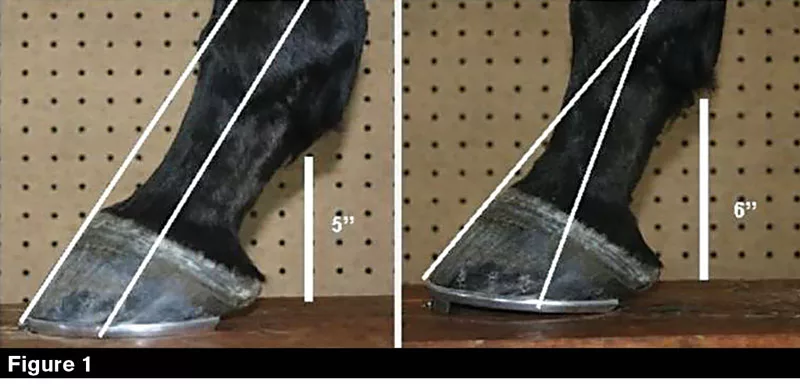A new traction device has found its way onto the prohibited list as the Horseracing Integrity and Safety Authority officially has updated and clarified its shoeing rules.
In a downloadable fact sheet titled “Shoeing Requirements,” HISA adds traction or mud nails to its list of prohibited devices on Thoroughbred racehorses. The list includes, but is not limited to toe grabs, bends, jar calks and stickers.
“A shoe with a flush toe insert would be compliant, but a shoe with an insert that extends below the ground surface of the shoe would not be allowed,” according to the fact sheet. “The use of toe grabs has been associated with an increased risk of fetlock injury, the major cause of racehorse fatalities due to musculoskeletal injury. Traction devices alter normal limb conformation (Figure 1), which can predispose to injury.”
While all traction devices are prohibited on turf, there is only one allowed on dirt and synthetic surfaces.
“The inclusion of a 2 mm (outer) rim (around the entire circumference of the shoe) is intended to provide an option for additional traction if conditions are warranted, without altering the conformation of the hoof relative to the ground surface,” Dr. Susan Stover, who chairs HISA’s Racetrack Safety Committee, told American Farriers Journal. “The 2 mm height is the maximum height that the rim can extend from the ground surface of the shoe.”
The shoeing rules contained within the Racetrack Safety Program have not been updated on the HISA website to reflect the changes as of June 16, 2022. The shoeing rules as stated in the program can be found in Section 2276 on Page 457. The rules go into affect Aug. 1.
“(a) Except for full rims 2 mm or less from the ground surface of the horseshoe, traction devices are prohibited on forelimb and hindlimb horseshoes during racing and training on dirt or synthetic racing tracks.
“(b) Traction devices are prohibited on forelimb and hindlimb horseshoes during training and racing on the turf.
“(c) Traction devices include but are not limited to rims, toe grabs, bends, jar calks and stickers.”
HISA’s Racetrack Safety Committee scrutinized rules and practices, as well as received suggestions from state racing commissions, racing participants and industry organizations while drafting the regulations. The Federal Trade Commission also solicited public comment before enacting the rules.
“These new rules will decrease fatalities by detecting horses with mild pre-existing conditions through expanded veterinary oversight and the review of medication and treatment records and training histories,” Stover says. “They will also provide a window into understanding and preventing the development of mild injuries in the first place via uniform surface maintenance standards and ongoing data analysis.”
According to an exclusive American Farriers Journal survey, 58% disapproved of the new federally mandated shoeing rules while 42% approved. Much of the opposition is rooted in the universal application of the shoeing rules while offering no latitude for variable climates, track surfaces, or horses.
Learn More
- Thoroughbred Racetrack Farriers Must Register with HISA by July 1: The Horseracing Integrity and Safety Authority has set a July 1 deadline for all Thoroughbred racing participants, including farriers, to register for access to restricted areas of a racetrack in the course of their work.
- HISA Clarifies Shoeing Rules, Confirms Delay: The Horseracing Integrity and Safety Authority confirmed that it is delaying the implementation of the federal Thoroughbred racetrack shoeing regulations, as well as clarification of its language.
- New Federal Horseshoeing Rules Create Controversy: Traction device ban sparks debate over horse health and concerns about race plate supplies.








